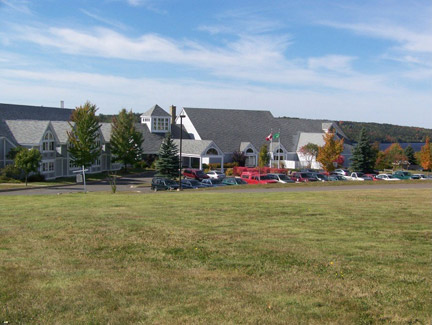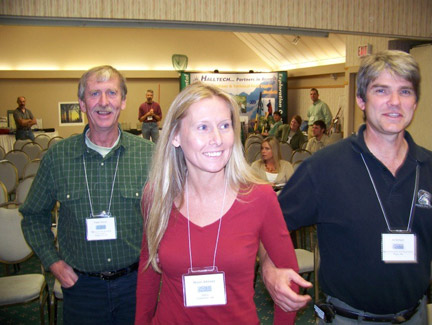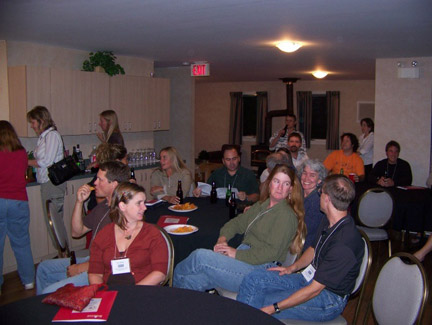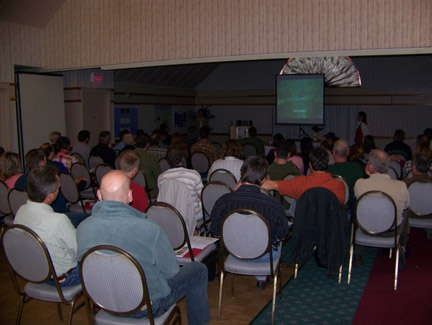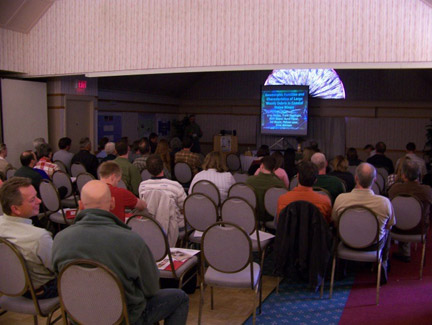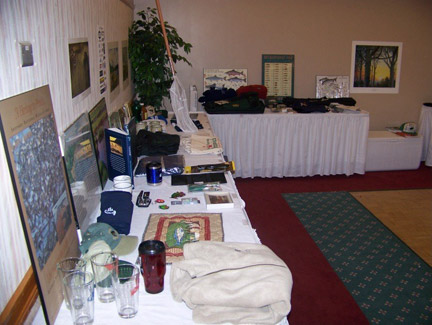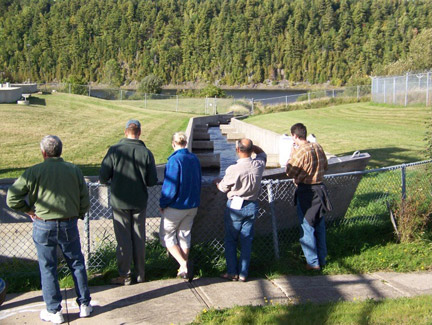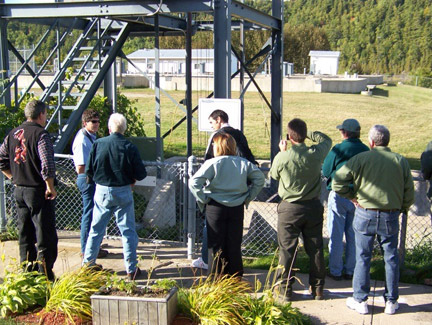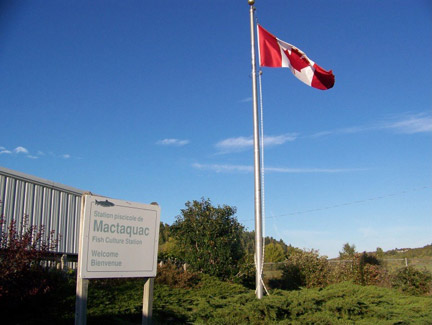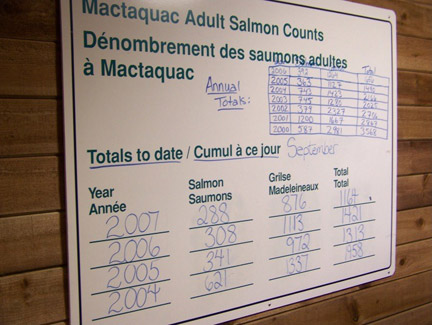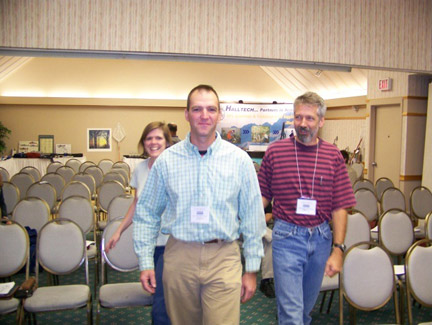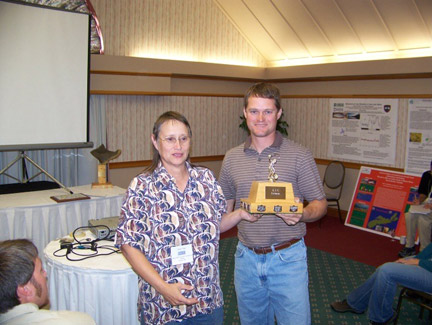Annual Meeting of the Atlantic International Chapter of the American Fisheries Society
September 23-25, 2007
Fredericton, New Brunswick
Hotel Information
Best Western Mactaquac Inn
Fredericton, New Brunswick
Conference Schedule
| Sunday, September 23rd | |
| 3:00 pm – 7:00 pm | REGISTRATION |
| 5:30 pm – 6:30 pm | STUDENT SUB-UNIT DEVELOPMENT MEETING |
| GENERAL SESSION (AND MIXER)CHAIR: Kathryn Collet | |
| 7:10 pm – 7:30 pm | Kathryn Collet – The trouble with Didymo (a.k.a. “It’snot funny”) |
| 7:30 pm – 7:50 pm | Frank Frost – Restoration of a limestone pond after thirty years of mining |
| 7:50 pm – 8:10 pm | Ross Jones – Atlantic salmon (Salmo salar) fall pre-smolt migration in relation to the Tobique Narrows hydroelectric facility |
| 8:10 pm – 8:30 pm | Merry Gallagher – Statewide Assessment for Wild Brook Trout Populations and Habitat inMaine: A Project Update. |
| 8:30 pm – 8:50 pm | Joan Trial – Short saga of an Atlantic salmon tidal temperature refuge |
| Monday, September 24th | |
| 7:30 am – 10:00 am | REGISTRATION |
| 7:00 am – 8:00 am | BREAKFAST |
| 8:15 am – 8:30 am | INTRODUCTION AND WELCOME |
| SESSION IChair: Peter Cronin | |
| 8:30 am – 8:50 am | Joan Trial – Antioxidants, Irrigation, and Atlantic salmon. |
| 8:50 am – 9:10 am | Terry Melanson – Ecological Restoration of Fish Habitat at the Watershed Scale. |
| 9:10 am – 9:30 am | Andy Smith – Fish Habitat Management at Canadian Forces Base Gagetown. |
| 9:30 am – 9:50 am | Tim Vickers – Managing Native Fish Habitat in an Urban Environment. |
| 9:50 am – 10:10 am | BREAK |
| 10:20 am – 10:40 am | Tara Marshall – Nova Scotia’s Learn to Fish Program. |
| 10:40 am – 11:00 am | Jason Czapiga – Habitat Connectivity: Dealing with the Small Stuff. |
| 11:00 am – 11:20 am | Steve Shepard – Dam removal and rock ramp fish passage to restore Sedgeunkedunk Stream alewife and Atlantic salmon populations. |
| 11:20 am -11:40 am | Jonathan Carr – Using Acoustic Telemetry to track the movements of adult alewives (Alosa pseudoharengus) in a freshwater and coastal zone in southwestern New Brunswick. |
| 12:00 pm – 1:00 pm | LUNCH |
| SESSION IIChair: Joan Trial | |
| 1:00 pm – 1:20 pm | Michael Bailey – Selective mortality of juvenile Atlantic salmon in Shorey Brook, Maine. |
| 1:20 pm – 1:40 pm | Melissa Laser – A Framework for Process-Based Restoration: Riparian Function andLarge Woody Debris Dynamics in an Atlantic Salmon River in Maine. |
| 1:40 pm – 2:00 pm | Ernie Atkinson – Status of Large Wood in Coastal Maine Atlantic Salmon Watersheds. |
| 2:00 pm – 2:20 pm | Gregory Mackey – Juvenile Atlantic Salmon Densities and Habitat Use in Naturally Occurring, High and Low Large Wood Sites in Old Stream, Maine, USA. |
| 2:20 pm – 2:40 pm | BREAK |
| 3:00 pm – 3:20 pm | David Cairns – Why has the American eel declined dramatically in the St. Lawrence River but not the Gulf? |
| 3:20 pm – 3:40 pm | Jason Hallet – Is the American eel primarily a marine species? |
| 3:40 pm – 4:00 pm | Reg Madden – Biological Characteristics and Population Status of Anadromous Brook Trout (Salvelinus fontinalis), 66 Years after an Initial Study in Moser River, Nova Scotia, Canada |
| 4:00 pm – 4:20 pm | Jason Leblanc – Historical changes in the distribution of smallmouth bass, Micropterus dolomieui, in Nova Scotia and preliminary assessment of nesting success. |
| 4:30 pm – 6:00 pm | TOUR – MACTAQUAC BIODIVERSITY FACILITY |
| 6:30 pm – 7:30 pm | DINNER |
| 7:30 pm – 9:00 pm | POSTER PRESENTATIONS |
| Mark Gautreau – Ecology of the Redbreast Sunfish Lepomis Auritus in Yoho Lake, New Brunswick. |
|
| Allen Curry – Maternal Transfer of Carbon and Nitrogen to Progeny of Sea-Run and Resident Brook Charr. |
|
| Cindy Breau – Behaviour at high temperatures: can physiology explain movement of juvenile Atlantic salmon (Salmo salar) to cool water? |
|
| Katrina Chu – Examining the Importance of Marine-Derived Nutrients to Freshwater Stream Productivity within the Inner Bay of Fundy. |
|
| Brianna Wyn – Factors Affecting Mercury Concentrations in Fish from Acidified Food Webs in Kejimkujik National Park, Nova Scotia. |
|
| Tim Jardine – Are coal-fired power plants affecting mercury concentrations in organisms in nearby streams? |
|
| Rosalyn Smedley – Stream and catchment scale effects on fish condition and community composition in an agricultural landscape. |
|
| Tuesday, September 25th | |
| 7:00 am – 8:00 am | BREAKFAST |
| 8:00 am – 9:50 am | BUSINESS MEETING |
| 9:50 am – 10:10 am | BREAK |
| SESSION IIIChair: John Magee | |
| 10:20 am – 10:40 am | Eva Walker – Circulating glucose dynamics and stress response to acute stress in two Percids: Johnny darter (Etheostoma nigrum) and yellow perch (Perca flavescens). |
| 10:40 am – 11:00 am | Lisa Bowron – Exploring the effects on white sucker (Catostomus commersoni) during pulp mill closure and restart. |
| 11:00 am – 11:20 am | Jennifer Adams – Fish reactions to exposure in oil refinery effluent and sediment in the laboratory and field. |
| 11:20 am – 11:40 am | Leslie Carroll – The reproductive biology of northern redbelly dace (Phoxinus eos) and their restricted use as a sentinel species for environmental effects monitoring programs. |
| 11:40 am – 12:00 pm | RAFFLE AND FISHING CONTEST AWARDS / WRAP-UP |
| 12:00 pm – 1:00 pm | LUNCH |
Abstracts
Primary Author:
Merry Gallagher
ME Inland Fish & Wildlife
Bangor, Maine
[email protected]
Title: Statewide Assessment for Wild Brook Trout Populations and Habitat in Maine: A Project Update
Maine maintains the majority of healthy brook trout populations remaining in the US, but suffers from a poor understanding of its stream trout resources. Also, a recent threat assessment of wild trout identified habitat fragmentation, forestry and agriculture as the primary contributors to habitat loss and degradation. Surveyed western Maine streams indicate extensive stream degradation. Much probably dates from past log drives. However, log drives have not occurred there for nearly a half century, and it is likely that current land use contributes to continued stream instability. The effects of forestry and agriculture on Maine’s streams may include accelerated runoff, loss of LWD, solar warming, and increased sedimentation. Hence, we have undertaken a
statewide stream survey effort to assess fish community structure and stream condition for fishery management and conservation planning.
Primary Author:
Joan Trial
DMR – Bureau of Sea Run Fisheries and Habitat
Bangor ME
[email protected]
Title: Antioxidants, Irrigation, and Atlantic salmon
Wild blueberries, advertised as “nature’s #1 antioxidant super fruit”, require about 2.5 cm of water per week during late June and all of July when fruit is forming and maturing. To reduce annual variation in production Maine’s larger low bush blueberry growers began rapidly expanding the acreage under irrigation in the 1990’s. As a result of increased acreage and irrigation, Maine blueberry production averaged 31.3 million kg from 1990 to 2002 compared to 14.4 in the previous 12-year period. The watersheds where blueberries are grown contain a portion of the Endangered Gulf of Maine Distinct Population Segment of Atlantic salmon (Salmo salar). Initially all irrigation water was taken from surface sources and some withdrawals directly degraded salmon habitat. Following a significant effort coordinated by the Maine State Planning Office, the large growers within watersheds inhabited by Atlantic salmon shifted irrigation sources to storage impoundments and groundwater. I will identify the players and their roles and summarize the processes and information that helped moved the blueberry industry to acknowledge fish habitat as a legitimate competing water use, and discuss ongoing issues related to hydrologic and ecological limits on water use in Atlantic salmon watersheds.
Primary Author:
Terry Melanson
Fisheries and Oceans Canada
Moncton, NB
[email protected]
Title: Ecological Restoration of Fish Habitat at the Watershed Scale
Over the last few years, many fisheries related issues have reminded us of the fragility of our aquatic resources. Humans can no longer turn a blind eye to declining or changing fish populations, fish habitat destruction, sedimentation and pollution from poor land practices, urbanization, etc. Humans directly and indirectly impact fish and fish habitat because of their practices. However, many of these impacts can be mitigated through effective environmental management and, although challenging, damaged fish habitats can be often be restored. The manual “Ecological Restoration of Degraded Aquatic Habitats: a Watershed Approach” (DFO,
2006) outlines sound principles and provides helpful guidance in meeting the challenges of fish habitat restoration. The ecological restoration approach provides a framework for action and a systematic method for addressing common fish habitat limiting factors such as: (1) fish passage,
(2) point source and non-point source pollution, (3) riparian zone quality, & (4) physical aquatic habitat quality. To succeed, the approach requires that DFO get the buy-in from its partners (e.g. all levels of government, industry, funding agencies, environmental groups, & academia) and that
its partners are willing to plan collaboratively. In the Maritime provinces, efforts are underway and several initiatives have begun to address issues that are limiting fish habitat productivity. Such initiatives include: – Fish passage improvements in New Brunswick – three dams were removed in
the Miramichi watershed and 100 fishways were installed in culverts allowing for improved fish migration. – Protocols were developed to assess fish passage at culverts. This is a joint effort between DFO, provincial departments of transportation, and environmental groups. Fragmentation will be assessed in three watersheds. – Nutrient pollution is being addressed in PEI estuaries. – Riparian management strategy in Atlantic Canada. Methods for assessing riparian zones are currently being developed. The goal is to develop better management
practices with the participation of government, agriculture industry, and environmental groups.
– Bank stabilization projects and fish habitat restoration are undertaken in partnership with NGOs.
– Protocol to identify sediment sources is underway and will be tested in 2008-09. The abovementioned undertakings are beginning to address the four categories of fish habitat limiting factors. However, efforts need to expand toward reducing the footprint of human activities on our environment. Only through a consistent and systematic application of the ecological approach will society prevail in improving fish habitat and reverse current trends.
Primary Author:
Andy Smith
Department of National Defense
Oromocto, NB
[email protected]
Title: Fish Habitat Management at Canadian Forces Base Gagetown
Canadian Forces Base Gagetown was established in 1952 to provide a training area for the army in Atlantic Canada. Training activities include artillery, armoured, infantry, engineering, brigade and battle group exercises. Some direct impacts to fish habitat due to base development and training have included channel diversion, improper culvert installation, removal of riparian vegetation and fording. Activities that have indirectly impacted fish habitat include land clearing, poor road construction and maintenance, and soil disturbance by military vehicles. Impacts to stream hydrology and sedimentation from these activities have been significant. Several programs, projects and partnerships have been initiated in order to address historic and ongoing impacts to aquatic environments and manage fish habitat. These include direct physical works such as stream enhancement and rehabilitation and measures such as training, planning and standing orders. A review of fish habitat management and related activities will be provided.
Primary Author:
Tim Vickers
Atlantic Coastal Action Program (ACAP)
Saint John, NB
[email protected]
Title: Managing Native Fish Habitat in an Urban Environment
The residents of Saint John, New Brunswick, have a well-documented history of using their natural resources as socio-economic capital. Marine and fresh water fisheries, logging, hunting, trapping and farming were all utilized for commercial, recreational and sustenance purposes. The subsequent development of Saint John into an industrial city brought with it substantial changes to the landscape, including the severe degradation of fresh and estuarine fish habitats. Fortunately, there now exists an unprecedented opportunity to not only reclaim native fish habitat, but to do so in a manner that adheres to the principles of urban sustainability. ACAP Saint John is currently developing a proposal to utilize the substantial environmental compensation associated with existing and pending industrial mega-projects to improve native fish habitat within our urban environment.
Primary Author:
Tara Marshall
Nova Scotia Fisheries and Aquaculture
Pictou, NS
[email protected]
Title: Nova Scotia’s Learn to Fish Program
Recreational Sportfishing has declined in Canada. Western provinces have addressed this issue by developing programs for youth. Nova Scotia has taken initiative to increase sportfishing by introducing a youth fishing program. Learn to Fish (L2F) was launched in 2006 in Halifax and was
designed to promote the sport fishery. L2F is aimed at youth to provide them with the education and skills to enjoy sportfishing. The classroom presentation includes local sportfish habitat and fishing basics. The outdoor lesson is a hands-on fishing session. Workshops are held in schools, community groups and camps. Teachers found the material complementary to topics in curriculum and reinforced healthy, outdoor living. L2F recruits the next generation of stewards of aquatic resources by teaching safe angling skills. L2F’s objective is to introduce youth to
sportfishing in a fun, safe environment with mentors that can teach basic angling. L2F’s goal is to ensure youth have a positive sportfishing experience.
Primary Author:
Jason Czapiga
Bureau of Sea Run Fisheries and Habitat
Department of Marine Resources
Bangor, Maine
[email protected]
Contributors:
Norm Dubé
Title: Habitat Connectivity: Dealing with the Small Stuff
Anthropogenic consequences of land use development have left a legacy of fragmented riverine habitats. Development fragmenting riverine habitat includes the construction of hydro, water storage, and log driving dams as well as a myriad of road networks across the landscape.
Strategies to mitigate these and to reconnect riverine habitat include constructing fish passage facilities at dams, removing outdated dams, and the installing of fish passage friendly culverts at road-stream crossings. While fish passage facilities and dam removals that cost several million
dollars get press and public support, remediating access to inaccessible critical smaller spawning and rearing streams due to improper culvert placement or culvert size can be forgotten. A number of large landowners, primarily forest based, have established a substantial road system in Downeast Maine over the past 30- 40 years to access forests, harvest trees, and haul logs to market. A secondary but equally important use arose from this road system: recreational access to remote areas for hunting and fishing. Because many of these roads are relatively new, especially secondary spur roads, many landowners have not needed to replace their original culverts. Replacing undersized or poorly placed culverts with natural bottom arch culverts as an approach to reestablish aquatic habitat connectivity maintains historical road access for forestry
and recreational uses. Other benefits include restoration of natural stream processes such as woody debris recruitment and sediment transport. We present several case studies as part of a strategy to reconnect 2nd, 3rd, and 4th order streams in Downeast Maine where five of eight Atlantic salmon populations listed under the Federal Endangered Species Act are located.
Primary Author:
Steve Shepard
Aquatic Science Associates, Inc.
Brewer, ME
[email protected]
Title: Dam removal and rock ramp fish passage to restore Sedgeunkedunk Stream alewife and Atlantic salmon populations
Sedgeunkedunk Stream, a tributary of the lower Penobscot River, drains a watershed of 54 square kilometers, including two mainstem lakes impounded by dams. These two dams, and a diversion dam near the stream mouth, were used to regulate and divert water for paper-making
processes. These three dams and several historic mill dams contributed to the loss of alewife and Atlantic salmon populations from the Sedgeunkedunk watershed. Because these dams currently have no provisions for upstream fish passage, restoration of alewife and salmon is precluded. This restoration project addresses fish passage at the lower two dams. The City of Brewer will remove the Lower Dam as part of a mitigation agreement thereby providing Atlantic salmon with access to suitable habitat upstream of the dam. The Town of Orrington intends to replace the Meadow Dam (located five kilometers upstream at the outlet of Fields Pond) with a rock ramp fishway. Alternatives analyses show that a rock ramp fishway best meets the goals of fish passage efficacy, wetlands protection, social acceptability, reasonable cost, and engineering
feasibility. An intensive outreach program provided information to stakeholders and documented support from natural resource agencies, non-governmental organizations, local government, abutting landowners, recreational users and the general community. Stakeholder support was
fostered by the efforts to include specific stakeholders issues in the alternatives analyses and implementation of the preferred alternative. Habitat mapping, water quality sampling and temperature data collection indicate that Sedgeunkedunk Stream habitat should provide spawning and nursery habitat for Atlantic salmon, and Fields Pond should do the same for alewife. Baseline biological sampling suggested by the Gulf of Maine Council’s Barrier Removal Monitoring Guide is currently underway to assess changes in the aquatic community after restoration. Although we have collected only scant preliminary data so far, we believe that
restoring alewife runs to the watershed will reinforce the key trophic link of littoral / pelagic zooplanktivore in the pond (currently represented by only one species, golden shiner), potentially allowing for increased diversity and resilience within the fish community. Furthermore, the
hypothesized increase in energy and nutrient fluxes due to alewife migrating within the pond and stream should increase diversity, production, and carrying capacity of stream fishes, including juvenile Atlantic salmon.
Primary Author:
Jonathan Carr
Atlantic Salmon Federation
St. Andrews, NB
[email protected]
Title: Using Acoustic Telemetry to track the movements of adult alewives (Alosa pseudoharengus) in a freshwater and coastal zone in southwestern New Brunswick.
In 2007, methods were developed to acoustically tag 20 adult alewives after they ascended a fish ladder at the Magaguadavic River’s head of tide hydroelectric dam, to document spawning movements and survival as they returned to the sea. No tagged fish moved more than 8 km upstream in the reservoir. Ten fish moved into a tributary lake of the reservoir and most resided there for several days. Fourteen fish were tracked back to the head of tide hydroelectric dam, some after post spawning and some a short time after release into the river. Five signals were lost at the dam face. Five fish were confirmed dead below the dam after passing through the turbines. Four fish successfully passed by the dam and were tracked out of the river through the coastal zone.
Primary Author:
Michael Bailey
University of Maine
Orono, ME
[email protected]
Title: Selective mortality of juvenile Atlantic salmon in Shorey Brook, Maine
Atlantic salmon (Salmo salar) restoration efforts in Maine employ fry stocking as one of the primary population restoration strategies. In the wild, some characters are often thought to correlate with high survival, such as large size or fast growth; however, there is little data on the
survival of newly stocked Atlantic salmon fry based on these characters. Hatchery rearing may reduce mortality in newly hatched fry. Nonetheless, natural selection may act strongly on stocked fry after they are released into the wild. These resulting survival patterns can be examined by reconstructing attributes of fry biology at stocking using characteristics of growth rings in otoliths. For this study, we compared otoliths (sagittae) from newly released fry and otoliths from stocked
fry spending between 30 and 60 days in the wild. Developing a relationship of fry biology to otolith characteristics for newly hatched Atlantic salmon may well be an important tool for describing selective mortality at early life stages. In addition, we have extensive mark – recapture data for salmon occupying freshwater environment. We can look to see if trends of selective mortality occurring during early life history remain constant throughout later life.
Primary Author:
Melissa Laser
Maine Department of Marine Resources
Augusta, ME
[email protected]
Title: A Framework for Process-Based Restoration: Riparian Function and Large Woody Debris Dynamics in an Atlantic Salmon River in Maine
Removal of the riparian forests along rivers in Maine began over 300 years ago during multiple land conversions, while channel alterations occurred directly from dams and log drives. These anthropogenic disturbances altered ecosystem processes, which impacted riverine ecosystem integrity and the ability to maintain biological diversity. Many ecosystem processes and species have been negatively affected by these disturbances, including the critically endangered sea-run Atlantic salmon (Salmo salar). Recovery of endangered species is complex and is guided by the Federal Endangered Species Act of 1973, which calls for the conservation of ecosystems as well as species. This study outlines a conceptual framework I developed for process-based restoration that focuses on ecosystem processes, because typical restoration approaches tend to ignore processes, whereas my framework presents a more holistic method. The framework consists of five steps:
(1) articulate the problem,
(2) treat and understand the symptoms of altered ecosystem
processes,
3) treat and understand the causes of altered ecosystem processes,
(4) identify and prioritize disrupted processes, and
(5) research processes and develop restoration options.
I use the example of the endangered Gulf of Maine Distinct Population Segment (DPS) of Atlantic salmon (Salmo salar) in the West Branch Sheepscot River and riparian function to illustrate the application of the framework. Recommendations for restoration of riparian function include managing the riparian forest for contributions of large woody debris (LWD) and placement of LWD in areas where the most benefit is likely to occur and where the pieces will be most stable. However, complete restoration of riparian function will take hundreds of years.
Primary Author:
Ernie Atkinson
Maine Department of Marine Resources
Jonesboro, ME
[email protected]
Title: Status of Large Wood in Coastal Maine Atlantic Salmon Watersheds
Atlantic salmon populations in Maine have remained at critically low levels since declining over the last two decades. Increasing freshwater productivity of Atlantic salmon seems necessary for recovery. However, it is unclear which environmental factors are limiting salmon in freshwater. We identified low levels of large wood in streams as a habitat feature that could affect productivity. Further, large wood has been shown to influence stream ecology and geomorphology in other regions, and can be manipulated and restored. We conducted a crossbasin
analysis in seven coastal Maine watersheds, documenting the size, frequency, volume, position, orientation, sediment storage, and pool forming function of large wood. In conjunction with these large wood surveys, we conducted extensive riparian vegetation surveys. We observed very low wood frequencies and volumes across the 60 km of rivers surveyed. Moreover, most of this wood was located parallel to flow in the immediate low flow channel and failed to span the stream channel. As a result, pool formation associated with large wood was generally lacking and less than 20% of the wood was associated with sediment storage. Low wood volumes are consistent with the relatively young riparian stands we observed, with the large majority of trees less than 20 cm diameter breast height. These results strongly reflect the legacy
of intensive timber harvest and land clearing, suggesting that the frequency and distribution of large wood may be considerably less than pre-settlement and future desired conditions. We also briefly discuss the status of a large wood restoration project.
Primary Author:
Gregory Mackey
Maine Department of Marine Resources
Jonesboro, ME
[email protected]
Title: Juvenile Atlantic Salmon Densities and Habitat Use in Naturally Occurring, High and Low Large Wood Sites in Old Stream, Maine, USA
Maine streams have large wood loads far below predicted levels, and notably low compared to other parts of the United States. Although extensive research has been done on the relationship between Pacific salmonids and wood, relatively little is known about the role wood plays in influencing juvenile Atlantic salmon populations. We tested two hypotheses in Old Stream, Maine via snorkel survey in sites with naturally occurring high and low wood densities: 1) the density of juvenile Atlantic salmon was higher in sites that contained high as opposed to low loading of wood, and 2) where wood was available, juvenile salmon tended to be associated with it within a site. We found that age 1+ or older juveniles were at significantly higher densities in sites with high wood loading, but substrate coarseness was a more important factor. We also found that a significant proportion of both age 0+ and older juveniles associated with wood in sites where it was available. However, this association also interacted with substrate coarseness and weed cover. These findings suggest that wood is an important habitat feature for juvenile Atlantic salmon, but cannot be viewed in isolation of other habitat factors. This work supports the need for greater understanding of the relationship between Atlantic salmon and wood in rivers.
Primary Author:
David Cairns
Fisheries & Oceans
Charlottetown, PE
[email protected]
Title: Why has the American eel declined dramatically in the St. Lawrence River but not the
Gulf?
The precipitous decline of American eels (Anguilla rostrata) in the upper St. Lawrence River and Lake Ontario (USLLO) has led to widespread concerns about eel conservation and to a COSEWIC assessment of Special Concern for the American eel in Canada. In contrast to the situation in USSLO, eel numbers in the St. Lawrence River estuary have shown modest declines, and numbers in the Gulf of St. Lawrence have increased in recent years. We tested the plausibility of hypotheses to explain these patterns by examining the match between the direction and timing of predicted effect and observed change. Patterns of observed population change could not be explained by dams, chemical pollution, dreissenid mussel invasion, Beauharnois ship passages, or density-dependent migration in the ocean. The dramatic decline of eels in USLLO and the moderate decline in the St. Lawrence estuary may be due to density-dependent watercourse penetration, where in times of decline, abundance in upstream areas drops sharply while abundance in downstream areas falls modestly. A 53-year time series of eel electrofishing densities in the Miramichi River, which flows into the Gulf of St. Lawrence, closely tracks the North Atlantic Oscillation (NAO), an index of Atlantic Ocean conditions. The Miramichi electrofishing index may be the best available long-term indicator of American eel recruitment from the ocean. Combined mortality from dams, contaminants, and fishing in the St. Lawrence system may reduce spawning escapement and depress recruitment of eels to the subsequent generation. The return of substantial eel populations to USLLO will be influenced by future oceanic conditions as reflected by NAO. Current conservation efforts in the St. Lawrence River emphasize increasing the availability of habitat upstream of dams. However, current levels of recruitment from the ocean are insufficient to fill these waters even if access is provided
Primary Author:
Jason Hallett
University of New Brunswick
Fredericton, NB
[email protected]
Contributors:
David Cairns
Title: Is the American eel primarily a marine species?
Recent otolith microchemistry studies have shown that some American eels (Anguilla rostrata) complete their life cycles in marine waters. However, Anguilla eels are still referred to as “freshwater eels,” implying that the majority occupy fresh water during the growth phase of their life cycle. We estimated eel populations in selected areas of the southern Gulf of St. Lawrence using electrofishing, mark-recapture, and nighttime surveys with a glass-bottom boat. Electrofishing surveys indicate a total of 972,000 eels in riverine habitat in southern Gulf drainages. Prince Edward Island has 39,000 ha of sheltered bay and estuary habitat with a depth less than 3 m. Based on densities derived from mark-recapture and glass-bottom boat surveys, the population of eels in marine habitats in PEI exceeds the population of eels in freshwater in all southern Gulf drainages. There are 65,000 ha of shallow and sheltered bay and estuary habitat in eastern New Brunswick. Patterns of commercial fishing effort suggest that most of this habitat is occupied by eels. There are also very large amounts of sheltered estuary and bay habitat elsewhere in eastern North America, especially in the eastern U.S. The American eel may be primarily a marine species, with only an atypical minority using freshwater as growth areas.
Primary Author:
John L. MacMillan
Nova Scotia Department of Fisheries and Aquaculture
Pictou, NS
[email protected], [email protected]
Contributors:
Reginald J. Madden
Title: Biological Characteristics and Population Status of Anadromous Brook Trout (Salvelinus fontinalis), 66 Years after an Initial Study in Moser River, Nova Scotia, Canada
Brook trout Salvelinus fontinalis are the most popular native sport fish in Nova Scotia. A decline in the annual catch of brook trout since the early 1980s may reflect a change in the resource. Nova Scotia’s relatively short river systems are believed to facilitate anadromy in many brook trout populations and these trout are important to the sport fishery. Live release traps and water quality measurements were used to assess brook trout population parameters and habitat in the same locations as in the historical studies conducted on the Moser River by Leverin (1939), White (1940 and 1941), Huntsman (1942), and Wilder (1952). In 2006, the timing of anadromous brook trout migration was similar in comparison to White’s study: downstream migration occurred in May and most upstream migration occurred in July. However, a greater proportion of upstream migrating brook trout were detected in June in 2006 compared to June of 1939 to 1941. The number of brook trout trapped per day in Mill Brook, a major tributary of Moser River, suggests that the median number of anadromous brook trout had declined in 2006 (1.5) compared to 1940 (9.5) and 1941 (18). A significant difference was detected in the number of brook trout trapped per day in 2006 compared to 1940 and 1941 (P< 0.05). Relative stock density of brook trout indicated that large trout in the 2006 population was less than that of historical levels. The proportion of brook trout (fork length >300 mm) captured migrating upstream was 3% in 2006 which was significantly less than 26% in 1940 (P< 0.05), and 27% in 1941 (P< 0.05). In 2006, fork length of anadromous brook trout was 221 mm ±25 (mean, SD) at two years of age and 276 mm ±34 (mean, SD) at three years of age and was similar to mean fork length at age from 1939 to 1943. The oldest brook trout aged was four years in 2006 and six years in 1939 to 1943. A maximum age of four years, for the 2006 study, was consistent with other recent studies on anadromous brook trout populations in Nova Scotia. During low flow periods in August, Moser River pH was 6.5 (0.35,SD) in 1939 and was 5.7 (0.15, SD) in 2006. Diatom inferred pH from a paleolimnological assessment of Mill Lake, located upstream of the Mill Brook trapping site, indicated an increase in acidity by a decline of pH 0.7 units from pH 6.8 in the 1930s. Diatom inferred Gran alkalinity changed from a pre impact range of 4.1 7.2 mg/L to a present day 0.6 mg/L (Ginn, Personal communication). Water temperature was warmer in 1939 compared to that in 1940 41 and 2006. In 1937 and 1939, mortality of salmon and trout in the Moser River occurred during warm low flow conditions (Huntsman 1942). A warming trend occurred over the past 140 years and the summers of 1937 and 1939 were two of the warmest on record for the Halifax region (Environment Canada). Changes in environmental conditions and exploitation may have influenced the size and age structure of the Moser River anadromous brook trout population.
The authors wish to thank the many professionals, volunteers and concerned anglers who participated in this project. Gordie Greencorn and Al McNeill, Nova Scotia Department of Fisheries and Aquaculture, Gerald Hardy, Gordie Naugler, Jim Lowe (Fisheries and Oceans Canada ), Arth Jewers, and Darren Pace all contributed to the data collection component of this study. Special thanks to Brittany Curry for her extensive fieldwork and Eddie Halfyard and J.P. Hastey for their assistance during the project. Peter Amiro, Fisheries and Oceans Canada, Science Branch, for providing White’s (1939-41) raw data allowing for a comprehensive comparison. We acknowledge Murray Hill and Don MacLean Nova Scotia Department of Fisheries and Aquaculture for providing resources for this survey.
Primary Author:
Jason LeBlanc
Nova Scotia Department of Fisheries & Aquaculture
Pictou, NS
[email protected]
Title: Historical changes in the distribution of smallmouth bass, Micropterus dolomieui, in Nova Scotia and preliminary assessment of nesting success
Smallmouth bass in NS have expanded their distribution by a factor of 20 since the first introductions into 9 lakes from 1942-1953. Additional areas were stocked in 1967 and two other lakes in 1971 and 1984. Despite not all stockings being successful and no further authorized introductions, there are now approximately 200 lakes containing bass in NS as a result of dispersals within watersheds, illegal introductions and accidental transfers. Geographical differences within NS causing temperature gradients, and limited growth potential may restrict or exclude colonization in several areas. A total of 493 nests were monitored in 8 lakes over a three year period. The percentage of successful nests ranged from 9.8 to 70.0. Habitat modeling identifies wildlife suitability corridors for dispersal within watersheds. A project to predict the likelihood of colonization of lakes not currently inhabited by bass was attempted using lake characteristics such as shoreline development and area.
Primary Author:
Eva Walker
Parish Geomorphic / UNB
Fredericton, NB
[email protected]
Title: Circulating glucose dynamics and stress response to acute stress in two Percids: Johnny darter (Etheostoma nigrum) and yellow perch (Perca flavescens).
Relatively little research has examined the glucose dynamics and stress responses, more specifically blood glucose, in small-bodied fish. Research examining glucose dynamics has taken place in the laboratory or hatchery and concentrates on large economically important species. Stream-side mesocosms were used to examine glucose regulation and the physiological stress response to suspended sediments in Johnny darter (Etheostoma nigrum) and juvenile yellow perch (Perca flavescens) over a 24 h period. Fish were subjected to a chase stressor and different concentrations of suspended sediments (0, 35, 350, 1500 and 3500 mg/L) as an environmental stressors. Stress was measured as changes in circulating blood glucose levels. Confinement without food increased glucose levels in both species, Johnny Darter (JD) from 3.5 ± 0.7 mmol/L at capture to 6.56 ± 0.9 resting and yellow perch (YP) 4.9 ± 0.3 mmol/L at capture to 6.4 ± 0.4 resting. Feeding did not appear to strongly influence glucose levels in JD. Yellow perch glucose levels showed sight regulation. Mean glucose level in Johnny darter at of 35 mg/L was slightly but significantly lower (5.1 ± 0.2 mmol/L) than zero turbidity controls (5.4 ± 0.2 mmol/L) and fish exposed to 350 mg/L (6.1± 0.3 mmol/L), 1500 mg/L (6.2 ± 0.3 mmol/L) and 3500 mg/L (5.4 ± 0. 2 mmol/L). The lower glucose levels at 35 mg/L may be indicative of a preference for slight turbidity, as it may allow cover from predators or increase prey contrast. Juvenile yellow perch did not demonstrate a significant relationship between sediment concentration and circulating glucose, and the pooled mean level was 8.4 ± 0.4 mmol/L.
Primary Author:
Lisa Bowron
University of New Brunswick
Saint John, NB
[email protected]
Title: Exploring the effects on white sucker (Catostomus commersoni) during pulp mill closure and restart
The impacts of pulp mills effluents on fish and fish habitat have been studied at Jackfish Bay, Lake Superior, Ontario, Canada since the late 1980’s. Jackfish Bay has received the effluent from a large bleached kraft pulp mill (BKM) in Terrace Bay, ON since 1948. The site is isolated from other sources of contamination, industrial or municipal effluents. Ongoing studies conducted since 1988, showed that white sucker (Catostomus commersoni) had a number of reproductive alterations, including delayed maturity, decreased gonadal size, decreased expression of secondary sexual characteristics, and depressed levels of circulating steroids. Reductions in gonad size and steroid levels persisted until the pulp mill closed its hardwood line in the late fall of 2005, and ceased all effluent discharge from its softwood line from February 2006 to September 2006. Fish were collected in the spring and fall of 2006 during shutdown, and then again 8 months after the mill reopened. Relative to their performance as measured with the previous 17 years of data, males recovered quickly after mill closure, as did steroid hormone levels in females. Persistent whole organism responses in females may be related to a time lag associated with recovery of their egg production. Continued studies will evaluate these questions.
Primary Author:
Jennifer R. Adams
University of New Brunswick, Canadian Rivers Institute
Saint John, NB
[email protected]
Contributors:
Deborah L. MacLatchy and Kelly R. Munkittrick
Title: Fish reactions to exposure in oil refinery effluent and sediment in the laboratory and field.
Examination of the potential toxicity of oil refinery effluent at the refinery in Saint John, New Brunswick, Canada has continued since 2002. The refinery is the largest in Canada, producing 270 000 barrels or oil/day and discharges 24 274 m3/day. Initial work found complications involving low dissolved oxygen content in the receiving environment, Little River, due to discharged ballast water mixed in with treatment effluent. The current study began in 2006 with investigations in the laboratory and in the field after ballast water was removed from the effluent. Laboratory experiments utilized bioassays with two resident fish species, mummichog (Fundulus heteroclitus, a brackish water fish) and northern redbelly dace (Chrosomus eos, a freshwater fish), exposed to effluent or effluent with river sediments. Field experiments included a fish community survey, water quality survey and fish caging experiments with mummichog and dace. Caging experimental results in mummichog indicated increased liver size and liversomatic index (LSI) downstream of the effluent outfall in both 2006 and 2007. Female testosterone levels were elevated and condition in both sexes was decreased downstream. Laboratory experiments have not indicated similar effects. A possible explanation for the difference is continued low dissolved oxygen in the river during the summer months, during field experiments, that have not been simulated in the laboratory.
Primary Author:
Leslie Carroll
University of New Brunswick, Canadian Rivers Institute
Saint John, NB
[email protected]
Title: The reproductive biology of northern redbelly dace (Phoxinus eos) and their restricted use as a sentinel species for environmental effects monitoring programs
Several small-bodied cyprinid fishes have been proven to be well suited for use as sentinel species in environmental effects monitoring programs. However, insufficient information on life history characteristics, reproductive strategy, mobility, longevity, and food habitats for a number of species challenges the design of studies and restricts the interpretability. Several cyprinid species spawn multiple times throughout the summer, and seasonal variability in the relationships between gonad and body weights can influence the detection of differences in reproductive performance. Past studies have established that Northern Redbelly Dace (Phoxinus eos) exhibit high variability in gonad weight: body weight relationships during the spawning season. The objective of this study was to follow seasonal changes in condition, liversomatic index, gonadosomatic index and ovarian histology to examine the reasons for gonad development variability among female redbelly dace. Fish were collected monthly from two lakes within Rockwood Park, NB from August 2005 to August 2006. Gonad development happened very quickly in both males and females prior to spawning, there appeared to be little synchrony between fish and gonad weight: body weight regressions were not significant for 8 months of the year, including all spawning months. As many as four clutches of eggs were observed within the ovaries of female redbelly dace during May, June, July and August suggesting that they spawn at least 7 to 10 times during the summer. While variability in some cyprinid species can be reduced by restricting sampling to specific times, or certain sizes or ages, it appears that there is no simple way to reduce the variability among northern redbelly dace to improve their utility as a monitoring species.
POSTERS:
Primary Author:
Mark Gautreau
Canadian Rivers Institute
Fredericton, NB
[email protected]
Contributors:
R. Allen Curry
Title: Ecology of the Redbreast Sunfish Lepomis Auritus in Yoho Lake, New Brunswick
In Canada, the redbreast sunfish, Lepomis auritus, is only located in south western New Brunswick which is the northern limit of the species. In 1989, The Committee on the Status of Endangered Wildlife in Canada (COSEWIC), listed it as a species of concern due to its limited distribution. In 2005, the New Brunswick Cooperative Fish and Wildlife Research Unit, was commissioned by COSEWIC, to provide an updated status report on the redbreast sunfish. During this process it became apparent that there was a void in data on Canadian populations of redbreast sunfish, making an appropriate assessment difficult. The purpose of this research is to begin to build an ecological data base for the redbreast sunfish in New Brunswick. Snorkeling surveys were conducted during spawning to assess habitat use during spawning. Nests averaged 51.1 cm in diameter and average depth of 46.5 cm. Nest substrate was sandy with small gravel and 41 % of the nests observed were associated with some structure. Mark recapture sampling was carried out using fyke nets and windemere traps. The average total length and weight were 12.6 cm and 43.4 g respectively. The population estimate for 2006 was 447 individuals. The length frequency distributions were consistent over years and seasons. Overall the population of redbreast sunfish in Yoho Lake appears to be healthy and stable.
Primary Author:
Allen Curry
Canadian Rivers Institute
Fredericton, NB
[email protected]
Title: Maternal Transfer of Carbon and Nitrogen to Progeny of Sea-Run & Resident Brook Charr
Early-life history characteristics of sea-run and resident salmonid fishes that co-exist in sympatry are poorly understood. To assess differences in characteristics of offspring of these two strategies following their emergence to the stream, stable isotope ratios (d13C and d15N) were used to identify the progeny of resident and sea-run female brook charr (Salvelinus fontinalis) in a tributary of the Miramichi River, New Brunswick, Canada. Upon emergence, sea-run progeny captured in emergence traps were longer, heavier, and had higher carbon to nitrogen ratios (C/N, an indicator of lipid content) than resident progeny, but did not have a higher body condition. After some feeding and growth in the stream, sea run progeny (still identifiable by their d13C and d15N) captured in dip-nets became longer, heavier, had higher C/N, and had higher condition than resident progeny. The proportion of fish caught in dip-nets at 11 sites where the two forms co-existed was dominated by offspring of sea-run females (sea-run = 56%, resident = 19%, unknown = 25%). These analyses suggest that offspring of sea-run, female charr benefit from maternally-derived energy reserves gained at sea and thus have potential adaptive advantages over offspring of residents.
Primary Author:
Cindy Breau
Canadian Rivers Institute
Fredericton, NB
[email protected]
Title: Behaviour at high temperatures: can physiology explain movement of juvenile Atlantic salmon (Salmo salar) to cool water?
During the summer, wild salmonids experience water temperatures that approach their upper lethal limit. In the Little Southwest Miramichi River (NB, Canada), juvenile Atlantic salmon of different age classes exhibit different behavioural responses to high temperatures (>23ºC). Yearling (1+) and two-year (2+) old salmon cease feeding, abandon territorial behaviour, and swim continuously in aggregations near cool water refugia; however, young-of-the-year (0+) fish continue to feed and defend territories. A laboratory experiment was conducted to determine 1) if the behavioural shift in older juvenile salmon occurs when basal metabolic rate, driven by increasing water temperature, approaches maximum metabolic rate; and 2) if anaerobic pathways were being recruited to provide energy to support vital processes. Behaviour (feeding, startle response), oxygen consumption, circulating lactate and glucose levels, and muscle lactate and glycogen were measured in fish acclimated to temperatures between 16 and 28ºC. Results indicate that oxygen consumption of the 2+ salmon increased with temperature and reached a plateau at 24ºC, a temperature that also corresponded to a significant increase in lactate levels and cessation of feeding. In contrast, oxygen consumption in 0+ fish did not plateau, feeding continued and lactate did not increase, even at the highest temperatures tested. We therefore conclude that some behavioural responses of 2+ salmon to temperature stress may be employed in an effort to mitigate the physiological imbalances associated with an inability to aerobically support basal metabolism.
Primary Author:
Katrina Chu
Canadian Rivers Institute, University of New Brunswick
Fredericton, NB
[email protected]
Title: Examining the Importance of Marine-Derived Nutrients to Freshwater Stream Productivity within the Inner Bay of Fundy
Overall productivity in the rivers within the Inner Bay of Fundy has been notably declining over the past several decades. Anthropogenic influences within the region have been primarily targeted as the reason for the decline of economically viable species, such as Atlantic salmon (Salmo salar). The decrease in upper trophic level species, however, may be due to an overall decrease in primary productivity that stems from the decreasing numbers of anadromous fish that migrate from nutrient-rich marine environments into these freshwater systems. Anadromous species, such as rainbow smelt (Osmerus mordax) and alewife (Alosa pseudoharengus), are born in freshwater, migrate to the sea and return inland to spawn, bringing with them marine-derived nutrients (MDN) that could potentially enrich the streams through which they travel. Declines in the amount of MDN in a stream system could lower primary productivity, thus, decreasing benthic marcroinvertebrate populations as well as the likelihood of juvenile fish survival and adult returns. This negative feedback loop would only continue to decrease productivity within streams. This study will evaluate the importance of MDN to stream productivity by: i) analyzing historical catch data to estimate the extent of marine-derived nutrients in Maritime rivers and; ii) determine whether artificial fertilization as a proxy for MDN is feasible as a means to increase and promote Inner Bay of Fundy fish populations.
Primary Author:
Brianna Wyn
University of New Brunswick, Canadian Rivers Institute
Saint John, NB
[email protected]
Title: Factors Affecting Mercury Concentrations In Fish From Acidified Food Webs In Kejimkujik National Park, Nova Scotia
Although fish from low pH lakes are known to have high mercury (Hg), it is not known if processes such as food web length or atypically high biomagnification contribute to these high concentrations. This study has two main objectives: 1) characterize the food webs of four acidic (pH< 6) lakes in Kejimkujik National Park, Nova Scotia to assess whether trophic structure and Hg biomagnification are enhanced in acidic systems; 2) revisit lakes sampled in the mid-1990s to determine whether Hg in yellow perch has decreased over the past decade. Invertebrates and yellow perch, golden shiner, and banded killifish were captured in 2006 from four food web lakes. Yellow perch and golden shiner were also caught in 6 additional lakes for temporal comparisons. Stable carbon and nitrogen isotopes and total Hg were measured to compare food web structures among lakes and to contrast against the mid-1990 Hg concentrations. Results from the abovementioned analyses will be presented and discussed.
Primary Author:
Tim Jardine
Canadian Rivers Institute
Fredericton, NB
[email protected]
Title: Are coal-fired power plants affecting mercury concentrations in organisms in nearby streams?
Coal-fired power plants are known to be significant sources of mercury (Hg) to the surrounding region. However, the possibility of enhanced bioaccumulation of Hg through stream food webs due to this localized deposition has rarely been examined, despite the potential risks to nearby aquatic populations. In 2006 we examined deposition of Hg onto the terrestrial landscape and its bioaccumulation through stream food webs by collecting the lichen Old Man’s Beard (Usnea sp.), benthic invertebrates, and fishes in a bulls-eye design at increasing distances away from a coalfired power plant in New Brunswick, Canada. Samples were analyzed for total Hg and stables isotopes of nitrogen (d15N) to determine trophic positioning. The terrestrial sentinel Old Man’s Beard indicated enhanced mercury deposition within 10 km of the plant and significantly elevated concentrations as far away as 100 km. Biomagnification of Hg within streams, as measured by slopes of the Hg-d15N relationships for invertebrates and fishes, was higher at sites near the power plant, and differences in the biomagnification of this pollutant also depended on the fish species present. Blacknose dace had higher mercury concentrations than brook trout leading to greater Hg-d15N slopes in streams containing only the former species. Biomagnification of Hg was also linked to water chemistry; acidic streams with high organic matter content showed greater slopes of Hg versus d15N. Future analyses will focus on separating the relative importance of water chemistry and the point source in the accumulation of Hg through these food webs to determine if the power plant may be negatively impacting aquatic populations and fisheating consumers including humans.
Primary Author:
Rosalyn Smedley
Canadian Rivers Institute, Department of Biology, University of New Brunswick
Fredericton, NB
[email protected]
Contributors:
R.A. Curry, J.Culp, and M. Gray
Title: Stream and catchment scale effects on fish condition and community composition in an agricultural landscape
Agricultural land-use can cause significant sediment input into adjacent streams. The severity of effects of suspended sediment input on fish has been modeled for southern USA streams based on duration and intensity of the sediment event, i.e., suspended sediment where effects is scored from no impact to mortality of fishes. The project will test the severity of ill-effects (SEV) impact assessment model in northern New Brunswick, a region comprising Canada’s third largest potato production region. Sixteen sites comprising a gradient of agricultural impact are being used to assess stream and catchment scale effects on fish. Environmental variables, such as suspended sediment levels, were collected throughout the agricultural season while electrofishing surveys were conducted in the late summer. The relationship between fish condition and environmental variables is explored to determine the most significant impact on health and community composition. Preliminary work found lower fish abundance in streams within the most intense potato production. Continuing research will establish the link between SEV, suspended sediment loading and other increased pressures from agriculture and the impacts on fish in Canadian waters
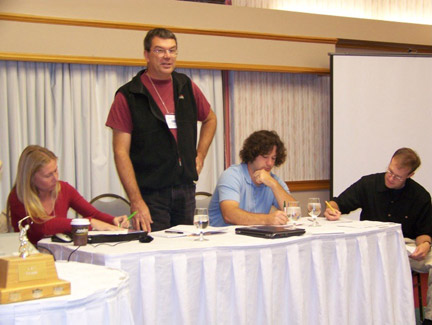
2007 Executive Committee from left to right- Alison Johnson (VP), Steve Shepard (President), Mike Bailey (University of Maine sub-unit President), John Magee (Treasurer).

Alison Johnson (incoming President, 2008) presents Steve Shepard (outgoing President, 2007) with a plaque on behalf of the AIC members for a job well done!
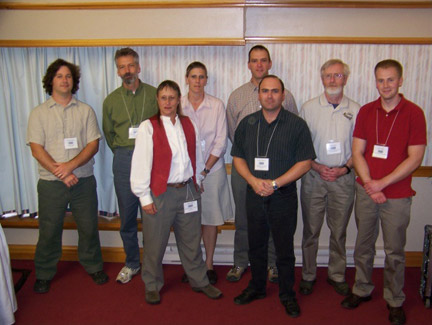
Monday afternoon presenters from left to right: Mike Bailey, Greg Mackey, Joan Trial (chair), Melissa Laser, Ernie Atkinson (VP – 2008), Jason LaBlanc, David Cairns, Jason Hallet.

Monday morning presenters from left to right- Tim Vickers, Jon Carr, Joan Trial, Tara Marshall, Jason Czapiga, Eva Walker, Steve Shepard (2007 – President), Terry Melanson and Peter Cronin (chair) missing from picture.

Sunday night informal session at the cabin, Kathryn Collet presents a topic that’snot funny – Didymo.

Tuesday morning presenters from left to right: John Magee (chair), Lisa Bowron, Jennifer Adams, Leslie Carroll, Andy Smith.

Lisa Bowron accepting the coveted “Soggy Boot” award for funniest fish picture. Incidentally, a photo of Lisa kissing her fish of choice, the White Sucker.



